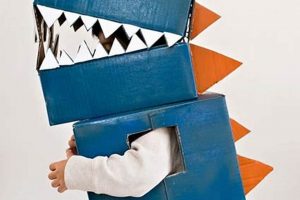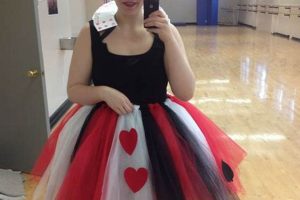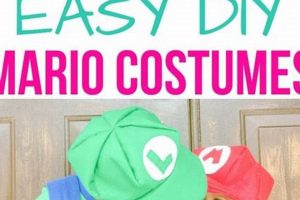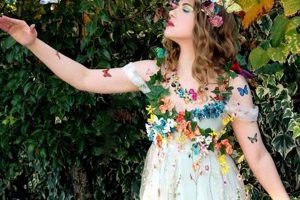Creating a homemade Merida-inspired garment allows individuals to replicate the iconic look of the Disney Pixar character using readily available materials and personalized design choices. For example, one might construct the dress from repurposed velvet or linen, embellishing it with Celtic-inspired embroidery for a more authentic feel.
This type of project fosters creativity, resourcefulness, and cost-effectiveness. Historically, crafting clothing at home was a necessity, and this contemporary application revives a traditional skill while offering a unique outlet for self-expression and character portrayal. Benefits extend to customization, ensuring a perfect fit and the selection of preferred fabrics and colors unavailable in mass-produced options.
The following sections will explore specific techniques for constructing various elements of the ensemble, including the dress, quiver, and wig, providing detailed instructions and material suggestions for a successful recreation.
Essential Tips for Creating a Merida-Inspired Costume
Constructing a successful Merida costume requires attention to detail and careful material selection. The following tips provide guidance for achieving an authentic and visually appealing representation of the character.
Tip 1: Fabric Selection is Paramount: Opt for natural fabrics like linen or a linen blend for the dress to achieve the correct drape and texture. Avoid overly synthetic materials, which can appear inauthentic.
Tip 2: Embroidery Enhances Authenticity: Incorporate Celtic knotwork or floral designs using embroidery floss. Templates are readily available online; transfer them carefully to the fabric prior to stitching.
Tip 3: Layering Adds Depth: Consider adding a chemise or underdress beneath the main gown. This layering technique increases the visual complexity of the costume and improves its historical accuracy.
Tip 4: Wig Styling Requires Patience: Merida’s iconic curls demand a high-quality wig and dedicated styling. Employ a wig brush and heat-safe styling tools to create the desired volume and ringlets.
Tip 5: Crafting the Quiver: Construct the quiver from durable leather or a leather-like material. Accurate scaling and secure strap attachments are crucial for a functional and aesthetically pleasing accessory.
Tip 6: Bow Detailing Matters: If including a bow, ensure it is appropriately sized and painted to match the film’s depiction. Consider adding decorative wrappings to the handle for added realism.
Tip 7: Footwear Completes the Look: Choose brown leather or suede boots or moccasins that align with the time period and character’s environment.
Adhering to these guidelines will significantly enhance the overall quality and accuracy of the Merida costume. Careful planning and execution are key to achieving a convincing and memorable portrayal.
These tips provide a foundation for a successful project. Subsequent steps involve detailed construction and creative refinement, enabling a unique and impressive final result.
1. Fabric Selection
Fabric selection is a foundational element when undertaking the creation of a Merida-inspired costume. The chosen textile directly influences the garment’s appearance, drape, comfort, and overall authenticity. Careful consideration of fabric properties is therefore paramount to achieving a convincing and durable result.
- Material Authenticity and Historical Accuracy
The selection of historically plausible textiles contributes significantly to the costume’s realism. Linen, wool blends, or even textured cotton, when properly treated, can evoke the feel of fabrics available in the historical period loosely referenced by the film. Using overtly modern synthetics can detract from the intended aesthetic.
- Drape and Silhouette
The way a fabric falls and moves dictates the garment’s silhouette. A heavy linen will drape differently from a lightweight cotton. Merida’s dress, with its relatively simple lines, benefits from a fabric possessing a moderate weight and subtle texture to create a natural and flattering shape. Stiff fabrics can result in an unflattering or unnatural appearance.
- Color and Dyeing Considerations
The color of the fabric impacts the overall visual impact. Natural dyes or dye techniques that produce muted, earthy tones are often preferable for achieving a historically inspired look. Overly vibrant or synthetic-looking colors can appear anachronistic. The fabric’s receptivity to dyeing is also critical if adjustments to the color are needed.
- Durability and Comfort
The chosen fabric should be sufficiently durable to withstand wear and tear. Natural fibers, properly cared for, generally offer greater longevity. Comfort is also a key factor, especially for costumes intended for extended wear. Breathable fabrics like linen or cotton are often preferable to less breathable synthetics.
These facets of fabric selection are interconnected and collectively determine the success of the Merida costume. A careful evaluation of these considerations ensures a finished product that is both visually appealing and functionally sound, contributing significantly to an effective Merida character portrayal.
2. Pattern adaptation
Pattern adaptation is a crucial component in the successful execution of a homemade Merida costume. Mass-produced patterns rarely conform precisely to individual measurements or desired design nuances. Consequently, modifying existing patterns or drafting new ones becomes essential for achieving a well-fitting and aesthetically accurate garment.
- Individual Measurement Adjustments
Commercial patterns are typically based on standardized sizing, which may not accurately reflect individual body proportions. Adapting a pattern to match specific measurements, such as bust, waist, and hip circumference, ensures a comfortable and flattering fit. This may involve grading between sizes, lengthening or shortening pattern pieces, and adjusting for unique body shapes.
- Design Modification for Accuracy
Achieving a screen-accurate representation of Merida’s dress often necessitates modifying the base pattern. This can include altering the neckline, adjusting the sleeve shape, adding or removing seams, and incorporating specific design details observed in the film. These modifications require a solid understanding of pattern drafting principles.
- Fabric Considerations and Adjustments
Different fabrics behave differently when sewn. A pattern designed for a stiff brocade may not translate well to a flowing linen without adjustments. Pattern adaptation accounts for the fabric’s drape, weight, and stretch properties, which may nece
ssitate altering seam allowances, adding or removing fullness, and modifying the lining construction. - Addressing Construction Techniques
Certain construction techniques may require pattern adaptations. For instance, incorporating boning for structure or adding a complex lining can necessitate changes to the pattern pieces. Similarly, adapting a pattern for hand sewing versus machine sewing may involve modifying seam allowances and construction order.
The interplay of individual measurements, design accuracy, fabric properties, and construction methods underscores the importance of pattern adaptation in “merida costume diy”. Mastering these skills elevates the final product from a simple imitation to a bespoke creation that captures the essence of the character while ensuring a comfortable and personalized fit.
3. Skill level
Proficiency in sewing and crafting techniques exerts a defining influence on the outcome of a homemade Merida costume. The requisite skill level directly dictates the complexity of design elements, construction methods, and overall degree of authenticity achievable in the final product.
- Basic Sewing Proficiency and Garment Construction
Fundamental sewing skills, including accurate cutting, seam finishing, and basic machine operation, are prerequisites for even simplified versions of a Merida costume. Inadequate proficiency in these areas can lead to misaligned seams, uneven hemlines, and an overall lack of structural integrity, compromising the garment’s fit and appearance.
- Pattern Alteration and Adaptation Competence
Commercially available patterns seldom provide a perfect fit without adjustments. The ability to alter patterns, grade between sizes, and adapt designs to accommodate individual measurements and desired design modifications constitutes a higher level of skill. Without this competence, the finished costume may lack the tailored fit and nuanced detailing characteristic of the character’s attire.
- Embroidery and Embellishment Expertise
The intricate Celtic-inspired embroidery that adorns Merida’s dress presents a significant challenge for less experienced crafters. Proficiency in hand embroidery techniques, such as satin stitch, stem stitch, and back stitch, or familiarity with machine embroidery processes, is necessary to replicate these details accurately. Lacking such expertise may necessitate simplification or omission of these embellishments, impacting the costume’s authenticity.
- Material Manipulation and Problem-Solving Capacity
Working with various materials, such as velvet, leather, and wig fibers, demands a certain level of dexterity and problem-solving ability. Successfully shaping and styling a wig to resemble Merida’s iconic curls, for example, requires patience, skill, and knowledge of hair styling techniques. Similarly, crafting a functional quiver from leather necessitates familiarity with leatherworking tools and methods. Inadequate material manipulation skills can result in frustration and a less polished final product.
These interconnected skill sets collectively determine the feasibility and ultimate quality of a Merida costume created at home. Aspiring costume makers should honestly assess their current abilities and select a project complexity that aligns with their level of expertise, ensuring a rewarding and successful creation.
4. Material Sourcing
Material sourcing represents a critical determinant in the success of any homemade Merida costume endeavor. The selection of appropriate fabrics, embellishments, and accessories directly impacts the costume’s authenticity, durability, and overall aesthetic appeal. Therefore, a thoughtful approach to acquiring these materials is essential for achieving a satisfying and convincing portrayal of the character. For example, the choice between genuine leather and a synthetic substitute for the quiver influences not only the final appearance but also the accessory’s longevity and functionality. Similarly, opting for historically accurate fabric weaves for the dress, even if more expensive, contributes significantly to the costume’s visual credibility.
Effective material sourcing involves several key considerations. Budget constraints often necessitate a balance between cost and quality. Repurposing existing materials or sourcing from discount fabric stores can reduce expenses, but may limit the range of available options. Conversely, investing in high-quality, ethically sourced materials can enhance the costume’s appearance and lifespan, but requires a more significant financial commitment. Ethical considerations also play a role, with an increasing awareness of sustainable and fair-trade practices influencing material choices. For example, selecting organic linen or recycled leather demonstrates a commitment to environmental responsibility. Furthermore, access to specialized suppliers may be necessary for obtaining unique components, such as custom-dyed yarn for embroidery or handcrafted accessories.
In summary, material sourcing is inextricably linked to the overall quality and realism of a Merida costume crafted at home. Informed decisions regarding fabric types, ethical considerations, and budget constraints are essential for realizing the creative vision. Thoughtful material selection enhances the costume’s authenticity and ensures a more rewarding and sustainable creation process. Failing to prioritize material sourcing can lead to a less convincing and potentially less durable final product, highlighting the practical significance of this component within the broader context of “merida costume diy”.
5. Time commitment
Adequate time allocation is paramount for successful execution of a Merida costume. The complexity of the design, the chosen materials, and the desired level of detail directly correlate with the time investment required for completion.
- Pattern Acquisition and Modification
Securing a suitable pattern, whether purchased commercially or drafted independently, necessitates dedicated time. Adapting this pattern to individual measurements and desired design alterations further extends this phase. Rushing this initial step often results in ill-fitting components and subsequent rework, ultimately increasing the overall time expenditure.
- Fabric Preparation and Cutting
Pre-treating chosen fabrics, such as washing or ironing, is essential for preventing shrinkage or distortion after construction. Accurate cutting of pattern pieces requires meticulous attention to detail, particularly with complex shapes or delicate materials. Insufficient time allocated to this phase can lead to fabric waste and inaccurate garment assembly.
- Garment Construction and Detailing
The actual sewing and assembly of the costume represent a significant time investment. Intricate details, such as hand-stitched embellishments, extensive embroidery, or complex seam finishes, demand considerable patience and focus. Hastening this phase can compromise the overall quality and authenticity of the finished product.
- Accessory Creation and Wig Styling
Crafting accessories, such as the quiver and belt, and styling a wig to emulate Merida’s distinctive hairstyle require specialized skills and dedicated time. These elements significantly contribute to the overall impression of the costume and should not be treated as afterthoughts. Neglecting sufficient time allocation can result in poorly executed accessories that detract from the garment’s impact.
The interconnectedness of these facets highlights the importance of realistic scheduling within the context of a homemade Merida costume. Underestimating the time commitment can lead to frustration, rushed execution, and a final product that falls short of expectations. A well-planned approach, with sufficient time allocated to each stage, ensures a more rewarding and successful costume creation experience.
Frequently Asked Questions
This section addresses common inquiries and concerns related to the creation of a homemade Merida costume, providing clarity and guidance for aspiring costume makers.
Question 1: What is the most suitable fabric for replicating Merida’s dress?
Linen or a linen blend is generally recommended due to its historical plausibility, natural drape, and breathability. Velvet may be considered for a more luxurious interpretation, but can be more challenging to work with. Avoid overtly synthetic fabrics, as they often lack the texture and drape of natural materials.
Question 2: How can Celtic knotwork embroidery be accurately reproduced?
Templates for Celtic knotwork are widely available online and can be transferred to the fabric using tracing paper or a fabric marker. Hand embroidery techniques, such as stem stitch and satin stitch, are effective for recreating these designs. Machine embroidery is also a viable option, but requires a digitized design and appropriate equipment.
Question 3: What is the best method for styling a Merida-inspired wig?
A high-quality, heat-resistant wig is recommended. Sectioning the wig and using a curling iron or hot rollers to create tight ringlets is a common approach. Hairspray and wig styling products can help maintain the curls’ shape. Patience and practice are essential for achieving the desired volume and texture.
Question 4: How should the quiver be constructed for durability and authenticity?
Genuine leather or a durable leather substitute is recommended for the quiver’s construction. A rigid internal structure, such as cardboard or plastic, can provide added support. Secure strap attachments are crucial for comfortable and functional wear. Attention to accurate scaling and detailing enhances the accessory’s authenticity.
Question 5: What are the common pitfalls to avoid when creating a Merida costume?
Common mistakes include selecting inappropriate fabrics, failing to adapt patterns to individual measurements, neglecting intricate design details, and underestimating the time commitment required for completion. Careful planning and attention to detail are essential for avoiding these pitfalls.
Question 6: Is prior sewing experience necessary to undertake a Merida costume project?
While not strictly mandatory, prior sewing experience is highly beneficial. Basic sewing skills, such as operating a sewing machine and understanding garment construction techniques, significantly improve the likelihood of a successful outcome. Beginners may consider starting with simplified versions of the costume or seeking guidance from experienced sewers.
The answers above highlight the importance of meticulous planning, appropriate material selection, and a realistic assessment of skill level when creating a Merida-inspired costume. Adhering to these guidelines can significantly enhance the final result.
The following section will delve into specific resources and tutorials that can aid in the successful completion of a homemade Merida costume.
Conclusion
The preceding exploration of “merida costume diy” has illuminated critical facets integral to the successful creation of a homemade garment. From fabric selection and pattern adaptation to skill assessment, material sourcing, and time management, each element contributes significantly to the final outcome. A thorough understanding of these aspects empowers individuals to embark on the construction process with informed awareness and realistic expectations.
The pursuit of replicating the character’s iconic attire necessitates careful planning, meticulous execution, and a commitment to detail. While the undertaking presents challenges, the potential for a unique and personalized creation remains a compelling motivation. As individuals contemplate this endeavor, a commitment to thorough research, skill development, and realistic self-assessment will ultimately determine the success of their “merida costume diy” efforts.





![DIY Hippo Costume: Make Your Own! [Easy Guide] The DIY Hub: Creative Crafts, Repairs & Life Hacks DIY Hippo Costume: Make Your Own! [Easy Guide] | The DIY Hub: Creative Crafts, Repairs & Life Hacks](https://craftingdiycenter.com/wp-content/uploads/2025/07/th-7233-300x200.jpg)

